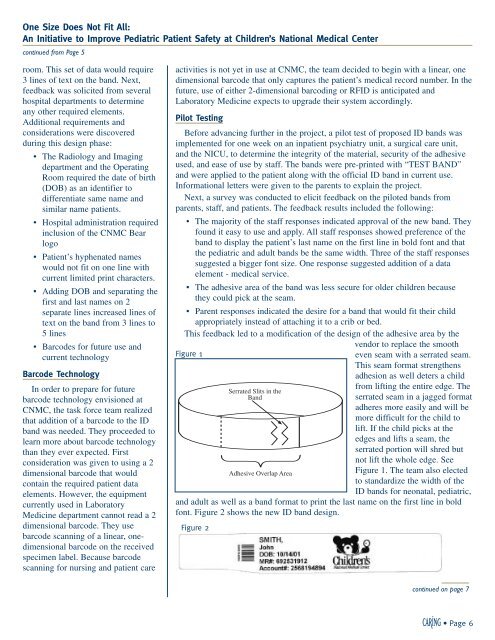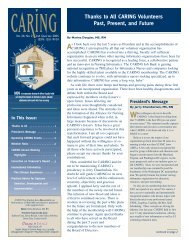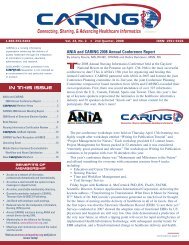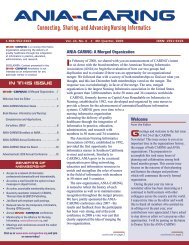Download - American Nursing Informatics Association
Download - American Nursing Informatics Association
Download - American Nursing Informatics Association
Create successful ePaper yourself
Turn your PDF publications into a flip-book with our unique Google optimized e-Paper software.
One Size Does Not Fit All:<br />
An Initiative to Improve Pediatric Patient Safety at Children’s National Medical Center<br />
continued from Page 5<br />
room. This set of data would require<br />
3 lines of text on the band. Next,<br />
feedback was solicited from several<br />
hospital departments to determine<br />
any other required elements.<br />
Additional requirements and<br />
considerations were discovered<br />
during this design phase:<br />
• The Radiology and Imaging<br />
department and the Operating<br />
Room required the date of birth<br />
(DOB) as an identifier to<br />
differentiate same name and<br />
similar name patients.<br />
• Hospital administration required<br />
inclusion of the CNMC Bear<br />
logo<br />
• Patient’s hyphenated names<br />
would not fit on one line with<br />
current limited print characters.<br />
• Adding DOB and separating the<br />
first and last names on 2<br />
separate lines increased lines of<br />
text on the band from 3 lines to<br />
5 lines<br />
• Barcodes for future use and<br />
current technology<br />
Barcode Technology<br />
In order to prepare for future<br />
barcode technology envisioned at<br />
CNMC, the task force team realized<br />
that addition of a barcode to the ID<br />
band was needed. They proceeded to<br />
learn more about barcode technology<br />
than they ever expected. First<br />
consideration was given to using a 2<br />
dimensional barcode that would<br />
contain the required patient data<br />
elements. However, the equipment<br />
currently used in Laboratory<br />
Medicine department cannot read a 2<br />
dimensional barcode. They use<br />
barcode scanning of a linear, onedimensional<br />
barcode on the received<br />
specimen label. Because barcode<br />
scanning for nursing and patient care<br />
activities is not yet in use at CNMC, the team decided to begin with a linear, one<br />
dimensional barcode that only captures the patient’s medical record number. In the<br />
future, use of either 2-dimensional barcoding or RFID is anticipated and<br />
Laboratory Medicine expects to upgrade their system accordingly.<br />
Pilot Testing<br />
Before advancing further in the project, a pilot test of proposed ID bands was<br />
implemented for one week on an inpatient psychiatry unit, a surgical care unit,<br />
and the NICU, to determine the integrity of the material, security of the adhesive<br />
used, and ease of use by staff. The bands were pre-printed with “TEST BAND”<br />
and were applied to the patient along with the official ID band in current use.<br />
Informational letters were given to the parents to explain the project.<br />
Next, a survey was conducted to elicit feedback on the piloted bands from<br />
parents, staff, and patients. The feedback results included the following:<br />
• The majority of the staff responses indicated approval of the new band. They<br />
found it easy to use and apply. All staff responses showed preference of the<br />
band to display the patient’s last name on the first line in bold font and that<br />
the pediatric and adult bands be the same width. Three of the staff responses<br />
suggested a bigger font size. One response suggested addition of a data<br />
element - medical service.<br />
• The adhesive area of the band was less secure for older children because<br />
they could pick at the seam.<br />
• Parent responses indicated the desire for a band that would fit their child<br />
appropriately instead of attaching it to a crib or bed.<br />
This feedback led to a modification of the design of the adhesive area by the<br />
Figure 1<br />
Serrated Slits in the<br />
Band<br />
Adhesive Overlap Area<br />
vendor to replace the smooth<br />
even seam with a serrated seam.<br />
This seam format strengthens<br />
adhesion as well deters a child<br />
from lifting the entire edge. The<br />
serrated seam in a jagged format<br />
adheres more easily and will be<br />
more difficult for the child to<br />
lift. If the child picks at the<br />
edges and lifts a seam, the<br />
serrated portion will shred but<br />
not lift the whole edge. See<br />
Figure 1. The team also elected<br />
to standardize the width of the<br />
ID bands for neonatal, pediatric,<br />
and adult as well as a band format to print the last name on the first line in bold<br />
font. Figure 2 shows the new ID band design.<br />
Figure 2<br />
continued on page 7<br />
CARING • Page 6







